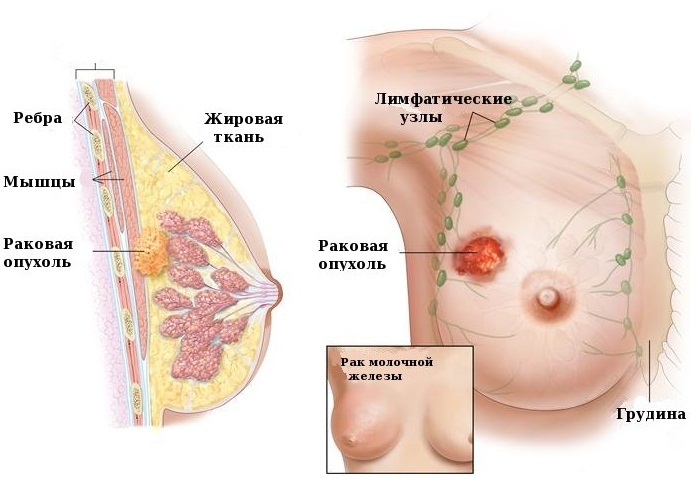Stabbing pain in the heart, like a sharp blow with a needle, is a dangerous and alarming symptom that indicates a possible the presence of a cardiological disease, a pathological condition of the respiratory or digestive organs systems.
Such sensations in the left side of the chest are just one of the signs of existing health problems. The specific type of disease that provokes this symptom is established based on the results of a comprehensive examination of the body.
Record content:
-
1 Possible reasons
- 1.1 Myocardial infarction
- 1.2 Angina pectoris
- 1.3 Pericarditis
- 1.4 Aortic dissection
- 1.5 Heartburn
- 1.6 Pleurisy
- 2 Diagnostics
-
3 Treatment methods
- 3.1 Changing your lifestyle
- 3.2 Treatment of manifestations of dyslipidemia
- 3.3 Antiplatelet therapy
- 3.4 Treatment with beta-blockers
- 3.5 Nitrate therapy
- 4 Possible consequences and complications
- 5 Tingling Heart Videos
Possible reasons
Stitching pains from the side of the heart, as when tissues come into contact with the sharp part of a needle, are a symptom of a large number of diseases.
Moreover, some types of pathologies are not directly related to the functions of the cardiovascular system. Despite this, the bulk of cases of acute stabbing pain in the heart acts as the first sign of a cardiac disease.
Myocardial infarction
Myocardial infarction is a severe damage to the tissues of the heart muscle. This disease is characterized by a methodical and progressive necrosis of the local area of the heart, which is caused by a violation of its blood supply.
In moments of acute shortage of a sufficient amount of blood, which is necessary for adequate nutrition myocardial tissues, there is an increase in pathological symptoms in the form of tingling in the heart.
Myocardial infarction most often develops in men and women, whose body is exposed to the following factors:
- tobacco smoking;
- high blood cholesterol levels;
- rheumatic heart disease;
- previously transferred streptococcal and staphylococcal infections;
- hypertonic disease;
- age-related changes in myocardial tissues;
- maintaining a sedentary lifestyle with minimal physical activity on the cardiovascular system;
- morbid obesity;
- frequent stress and psycho-emotional overstrain;
- complications of diabetes mellitus;
- chronic alcoholism;
- increased concentration of triglycerides in the blood.
According to medical statistics, myocardial infarction is more often diagnosed in men than in women.
In the presence of this disease, a person can feel not only a stabbing pain in the heart, but also the following symptoms:
- numbness of the left arm;
- pain in the shoulder or under the scapula;
- burning sensation behind the breastbone;
- chronic fatigue;
- the release of sticky sweat;
- dry cough attacks;
- shortness of breath, appearing at rest, as well as after minor physical exertion.
In medical practice, there are a large number of cases when the only symptom of an approaching myocardial infarction is periodic tingling in the heart. Then there is a sudden stop of the heart muscle with the onset of biological death of a person.
Angina pectoris
Colitis of the heart, like a needle, due to the possible presence of a cardiac disease in the form of angina pectoris. The first manifestations of this pathology are accompanied by a sharp tingling sensation on the left side of the chest, a feeling of pronounced discomfort in the retrosternal space.
Pain sensations increase sharply at the time of physical activity, stressful situations, or after completing a meal. An attack of angina pectoris begins with a tingling sensation from the side of the heart, and then the pain spreads to the neck, left shoulder joint, and lower jaw.
The acute phase of manifestation of pathological symptoms of angina pectoris lasts for 10-15 minutes. Pain sensations may disappear immediately after taking Nitroglycerin or other nitrates with a short spectrum of action.
The following classification types of angina pectoris are distinguished, which causes a stabbing pain in the region of the heart, reminiscent of the effect of a needle:
- stable angina pectoris caused by overstrain of the heart muscle;
- unstable angina;
- the first-ever attack of angina pectoris;
- progressive type of angina pectoris;
- vasoplastic angina pectoris;
- postinfarction or postoperative angina pectoris.
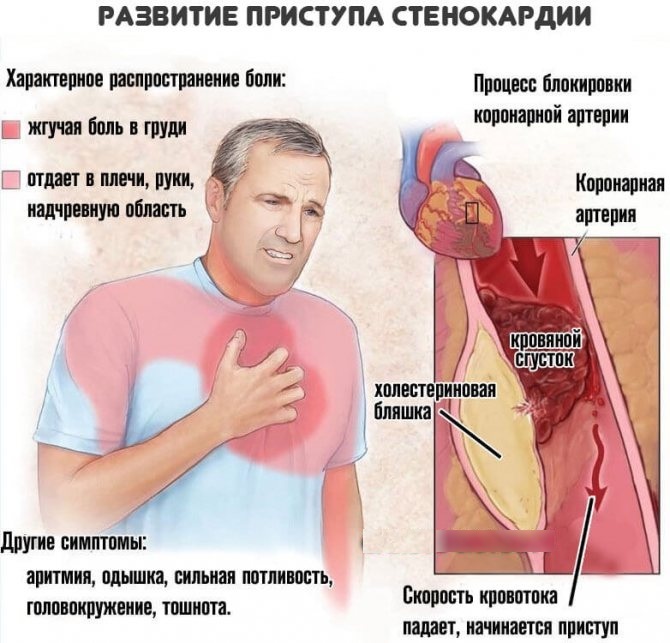 All of the above types of pathological conditions of the heart, which are accompanied by stabbing pain, are established after a diagnostic examination of the cardiovascular system. Angina attacks can occur when a person is in a state of complete physical rest.
All of the above types of pathological conditions of the heart, which are accompanied by stabbing pain, are established after a diagnostic examination of the cardiovascular system. Angina attacks can occur when a person is in a state of complete physical rest.
Pericarditis
Colitis the heart, like a needle, due to inflammatory processes that destroy the serous membrane of the heart muscle. Most often, the greatest damage is caused to the visceral leaf. In most cases, pericarditis is a complication of existing diseases of the body with a chronic form of the course. Much less often, this pathology acts as an independent heart disease.
By its nature of origin, pericarditis is classified into the following types:
- autoimmune, when heart muscle cells attack the patient's own cells of the immune system;
- traumatic, developed after severe heart injury;
- idiopathic, when it is not possible to establish the exact cause of the inflammatory processes in the heart muscle.
In the presence of this causative factor, which causes a stabbing pain in the heart, additional symptoms may appear in the form of:
- shortness of breath;
- decline in physical strength;
- attacks of dry cough with the release of blood clots;
- increased heart rate;
- spreading pain throughout the chest;
- weight loss.
Pericarditis is dangerous only if the disease is let go. In the conditions of timely diagnostics and adequate treatment, a person's working capacity is fully restored, or a slight decrease is observed.
Aortic dissection
Colitis of the heart, like a needle, due to the possible presence of a dangerous disease in the form of aortic dissection. This type of pathology is characterized by the fact that the walls of this blood vessel are divided into several layers, under which arterial blood flows.
This only accelerates further destruction of the structure of the main vessel. In the event that, as a result of prolonged dissection of the aorta, its all 3 layers are ruptured, then internal bleeding opens.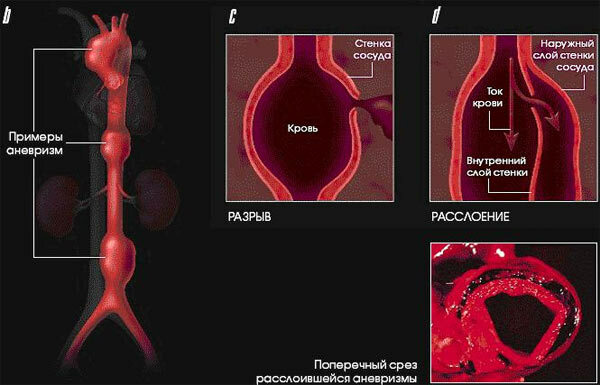
In such a situation, the probability of death is at the level of 95%, even if treatment is started on time.
This cause of tingling pain from the heart can develop under the influence of the following factors and pathological conditions of the body:
- arterial atherosclerosis;
- damage to the aorta with an infectious agent of syphilis;
- hypertension, the manifestation of which is accompanied by the presence of unstable blood pressure;
- focal necrotization of the walls of the aorta, which arose under the influence of bacterial-embolic processes;
- physical fatigue and a state of constant stress;
- Closed trauma to the abdomen or anterior chest wall
- damage to the walls of the aorta by concomitant diseases that develop in the immediate vicinity of the arterial vessel (for example, malignant tumor of the esophagus).
At the time of the appearance of the first sensations of stabbing pain from the heart, the process of aortic dissection progresses. The acute phase of this pathology lasts up to 14 days. According to medical statistics, about 70% of patients with a similar disease die in the first 2 weeks from the onset of its development.
Heartburn
Violation of the acidity level of gastric juice leads not only to discomfort in the area of organs digestive system, but can also cause symptoms resembling cardiac disease.
In this case, a tingling sensation in the heart occurs at the moment when acid contents are released from the stomach cavity into the esophagus. The walls of this organ of the gastrointestinal tract are under the influence of an aggressive environment, their chronic irritation develops, which causes the appearance of a stabbing pain in the left side of the chest.
To distinguish a cardiac disease from another attack of heartburn, it must be remembered that this is a pathological condition of organs. The gastrointestinal tract is accompanied by the following symptoms:
- aversion to sour or fatty foods;
- frequent belching;
- feeling of a full stomach;
- sour taste in the mouth, which can occur exclusively on an empty stomach, or after the next meal;
- burning sensation in the central part of the chest;
- bloating.
The appearance of heartburn, which causes false cardiac symptoms in the form of tingling from the heart, is most often associated with acute or chronic diseases of the digestive system. Elimination of pathologies of the gastrointestinal tract allows you to get rid of discomfort in the chest area.
Pleurisy
Colitis of the heart, like a needle, due to the possible presence of a serious illness in the form of pleurisy. This pathology is characterized by inflammation of the pleural sheets with the formation of fibrin particles on their surface, as well as the release of exudative fluid.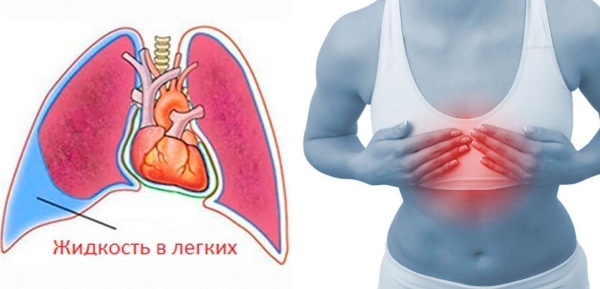
In this case, a person constantly or periodically feels stabbing pain from the heart, but the cause of the discomfort is not associated with cardiac disorders.
Inflammation of the pleura can develop under the influence of infectious microorganisms, tumor neoplasms of a malignant nature of origin or is a consequence of severe damage chest.
This pathology, causing stabbing pain in the heart area, is accompanied by the manifestation of the following symptoms:
- subfebrile temperature;
- pain inside the chest when turning or bending;
- a state of fever;
- excessive sweating;
- the presence of murmurs inside the chest, which are caused by friction of the hyperemic pleura;
- frequent and shallow breathing;
- dry cough.
The main danger of this disease lies in the real risk of developing severe complications, most of which lead to death. Pleurisy, accompanied by the accumulation of exudative fluid, causes the disappearance of vocal tremors and provokes severe pain inside the chest.
Diagnostics
The table below describes the main types of laboratory and hardware examination methods that must be performed in the presence of stabbing pain in the heart area.
| Diagnostics type | Characteristics of the survey process |
| Clinical analysis of capillary blood | This type of diagnosis allows you to establish a possible change in hemoglobin parameters, a decrease or increase in leukocyte cells. A clinical analysis of capillary blood detects leukemia, anemia, and erythremia, the presence of which can provoke ischemic myocardial disease. The average cost of this type of diagnostics is 540 rubles. |
| Identification of biochemical markers | For this study, the patient's venous blood is used. The main purpose of diagnostics is to determine troponin parameters, an increase in the level of which indicates the possible presence of coronary syndrome with an acute phase of the course. The average cost of this type of examination is 1,030 rubles. |
| Blood chemistry | All patients who complain of stabbing pain in the heart area, have concomitant signs of cardiac disease, it is recommended to take this type of analysis. The main purpose of the study is to determine the level of cholesterol, triglycerides, creatinine, as well as other biochemical substances that have a direct effect on the work of the heart. The price of a biochemical analysis of venous blood is within 690 rubles. |
| Resting ECG | The principle of this type of diagnosis is that the patient does not expose his heart to any physical or psycho-emotional stress. Upon completion of the electrocardiogram fixation, its results are deciphered by a cardiologist. The average cost of an ECG in a private clinic is 720 rubles. |
| Bicycle ergometry | Bicycle ergometry is an electrocardiogram reading when the patient's cardiovascular system is under the influence of physical activity. This type of diagnosis allows you to establish hidden diseases of the heart and blood vessels. The average cost of bicycle ergometry is 2500 rubles. |
| Echocardiography | Echocardiography is necessary to determine pathological changes in the structure of the heart. The doctor checks this organ for the presence of cardiomyopathy with signs of hypertrophy, congenital or acquired valve defects, dysfunctional disorders of the ventricles. The average cost of echocardiography is 1250 rubles. |
If there is objective suspicion of concomitant diseases of the gastrointestinal tract or pleural cavity, the patient is assigned to undergo gastroscopy, radiography or MRI diagnostics. Particular attention is paid to the possible presence of inflammatory processes and neoplastic neoplasms.
Treatment methods
Treatment of cardiac diseases that provoke stabbing pain in the heart requires an integrated approach.
Changing your lifestyle
A person who constantly or periodically feels a tingling sensation in the area of the heart has a disease of this organ,Must follow these guidelines:
- give up smoking;
- exclude the use of fatty, salty, smoked food;
- bring body weight to normal indicators in accordance with your height;
- eat more fresh fruits, vegetables, herbs and seafood;
- provide the muscular system, heart and blood vessels with moderate physical activity.
Compliance with the above rules should be accompanied by a course of drug therapy, which is aimed at normalizing the functions of the heart.
Treatment of manifestations of dyslipidemia
In patients with signs of high cholesterol levels, the presence of a real risk of myocardial infarction, a course intake of hapolipidemic drugs is prescribed, which belong to the category of inhibitors HMG-CoA reductases.
The main goal of the therapeutic process is to reduce lipid levels that are too high to 4.5 mmol per 1 liter of blood. The specific type of drugs, dosage and duration of treatment are determined by the attending physician, depending on the current test results.
Antiplatelet therapy
Patients with stabbing pain in the heart caused by angina pectoris or the risk of myocardial infarction are prescribed acetylsalicylic acid in a quantitative dosage of 75 to 150 mg per day.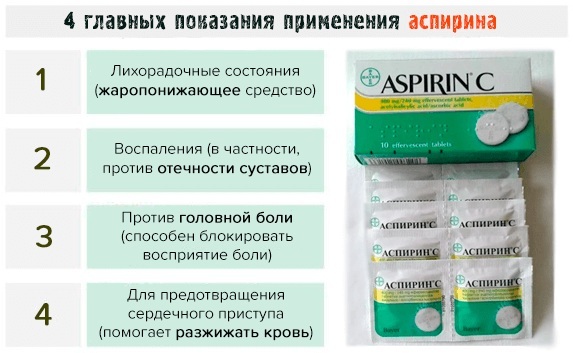
At the initial stage of treatment, the minimum doses are selected at which the therapeutic effect is achieved. A sharp increase in doses of antiplatelet drugs is fraught with the opening of gastrointestinal bleeding.
Treatment with beta-blockers
This type of drug is used as a symptomatic treatment. Taking medications from the pharmacological group of beta-blockers is necessary to relieve an acute attack of angina pectoris or to quickly provide myocardial cells with an additional amount of oxygen.
Beta-blockers are taken at the time of intensification of stabbing pain in the heart, which is accompanied by shortness of breath, dizziness, and a burning sensation inside the chest. The type of drugs in this group is selected by the attending physician, depending on the patient's final diagnosis. In medical practice, the most commonly used drugs are Atenolol, Metoprolol, and Bisoprolol.
Nitrate therapy
In cardiology, there are 3 essential nitrate-based medicines. These are medicines called Isosorbide Mononitrate, Nitroglycerin, and Isosorbide Dinitrate.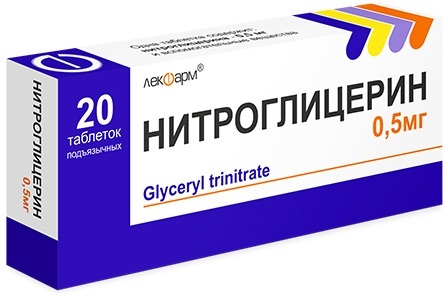
Drugs in this category have a fast, but not long-lasting effect. Nitrates are taken in 5-10 minutes. before the expected physical activity or at the time of the acute phase of a heart attack, accompanied by stabbing pain in the chest, shortness of breath, weakness.
The mechanism of action of nitrates is the expansion of blood vessels and a decrease in the pathological tension of the heart muscle. The selection of a specific type of medication in this group should be performed by the attending physician based on the results of the examination.
It is important to remember that a violation of the dosage regimen with nitrates can lead to the development of orthostatic hypotension, tachycardia and an increasing attack of angina pectoris.
Possible consequences and complications
Stitching pains in the heart that feel like a needle hit can be a sign of a dangerous heart disease.
Lack of timely diagnosis and properly organized treatment entails the development of the following complications:
- hypertonic disease;
- myocardial infarction;
- cerebral stroke;
- coronary heart disease;
- rupture of the aorta with the opening of extensive internal bleeding;
- progressive angina pectoris;
- sudden stop of the heart muscle with the onset of death.
In order to prevent the occurrence of the above complications, it is necessary at least once every 12 months. undergo a preventive examination by a cardiologist, passing an ECG and echocardiography. When the first signs of discomfort inside the chest appear, you should immediately contact your local therapist.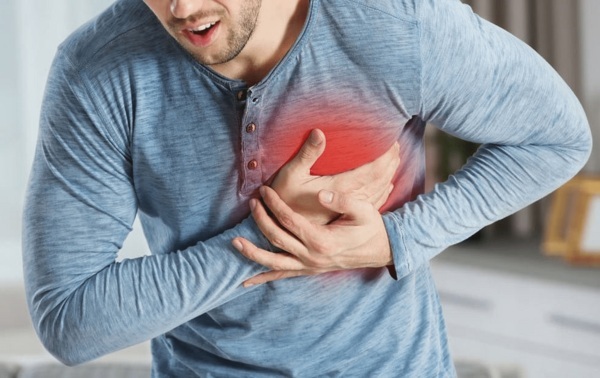
A stabbing pain in the heart, like the touch of a needle, is a possible sign of cardiac disease, unstable functioning of the organs of the gastrointestinal tract, or pathology of arterial vessels.
The appearance of this symptom is the basis for a more detailed check of the functions of the heart muscle, esophagus, stomach and intestines. A feeling of discomfort inside the chest, accompanied by shortness of breath, physical weakness and dizziness, is most often a sign of angina pectoris or the imminent development of myocardial infarction.
To stabilize the work of the heart, it is recommended to change your lifestyle, give up fatty foods, smoking and drinking alcohol. Relief of heart attacks is carried out with the help of symptomatic therapy in the form of beta-blockers, nitrates, anticoagulants.
Tingling Heart Videos
Why the heart is pricking like a needle:



